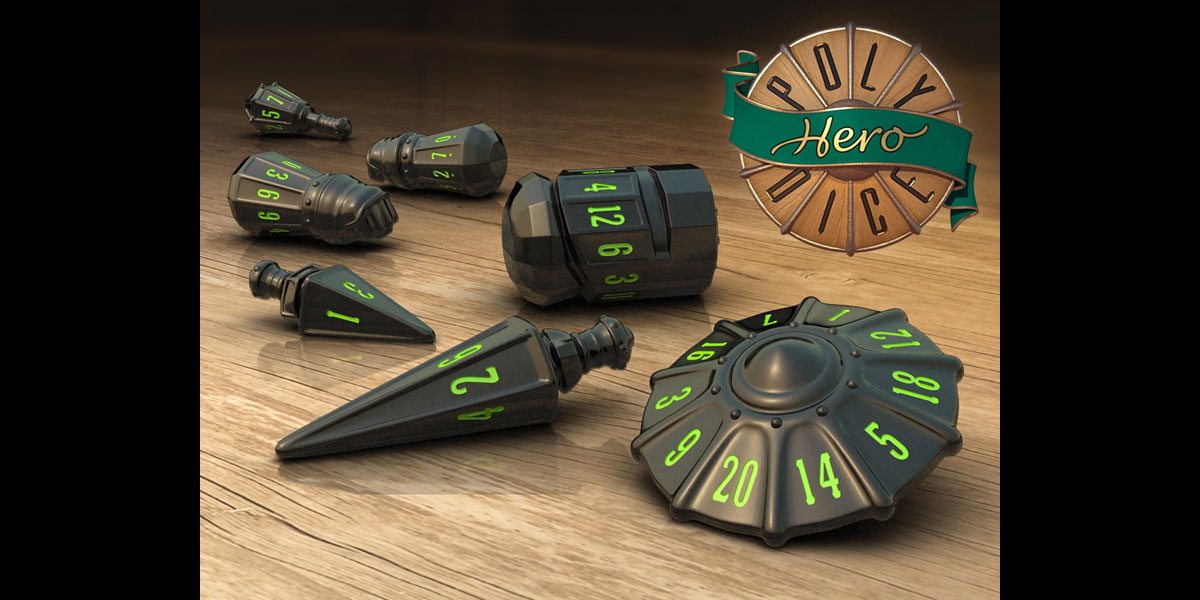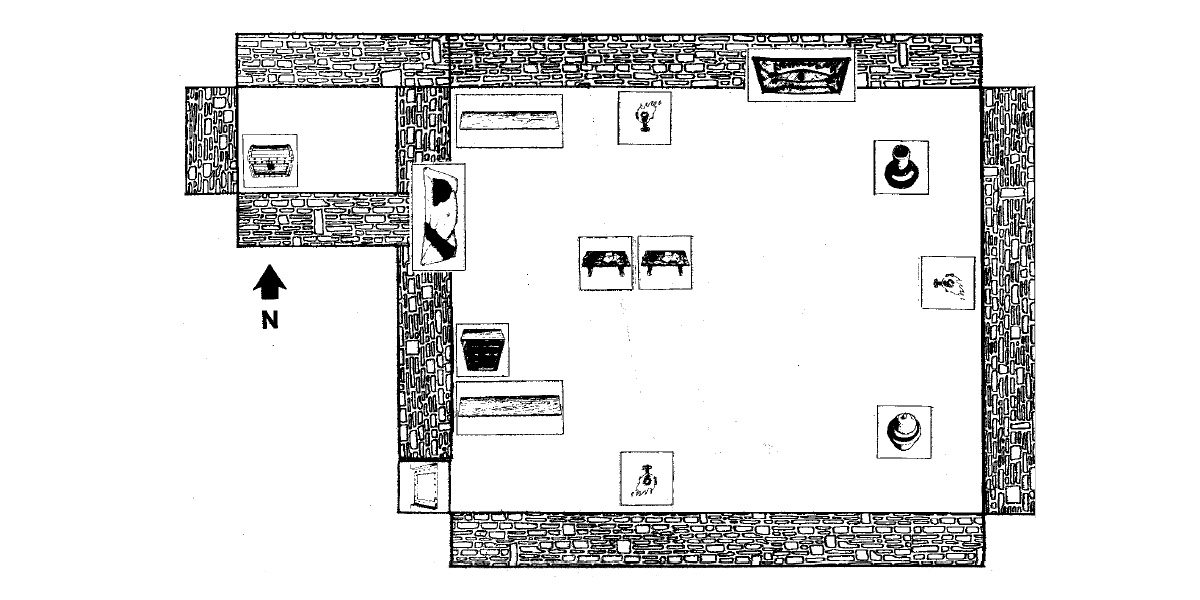The king has died, and the kingdom is in turmoil. The various guilds of Tessandor must work together to fulfill quests, stem the tide of monsters, and fulfill the Queen’s orders to bring peace back to the kingdom.
At a glance: By Order of the Queen is a cooperative game for 2 to 4 players, ages 10 and up, and takes 90–120 minutes to play. It is currently seeking funding on Kickstarter, with a pledge level of $49 for a copy of the game. (There’s also a $100 pledge level that includes an original ink drawing of artwork from the game.) As of this writing, the game has already reached its funding goal and hit a couple of stretch goals, so make sure you check the Kickstarter page for the latest information. The game has a light RPG feel to it and is designed to be kid-friendly, so the artwork tends toward the cute rather than the terrifying, and I think the age rating is about right. (That said, I did also play it with my 3-year-old, who loved it.)
New to Kickstarter? Check out our crowdfunding primer, and visit our curated page for more projects we love.
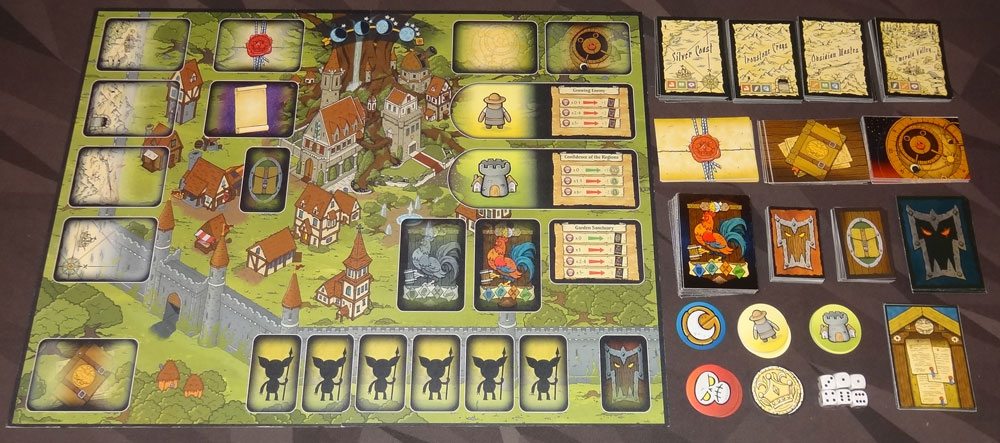
Components
- Game board
- 64 Hero cards
- 45 Item cards
- 40 Monster cards
- 4 Nemesis cards
- 19 Event cards
- 12 Queen’s Order cards
- 24 Quest cards
- 8 Guild cards
- 100 Location cards (25 each in 4 different locations)
- 80+ tokens
- 10 Dice
Note: my review is based on a prototype, so the list is subject to change and my photos do not reflect final component quality. For instance, all of the tokens in the prototype are paper instead of cardboard, and are larger than the final versions will be.
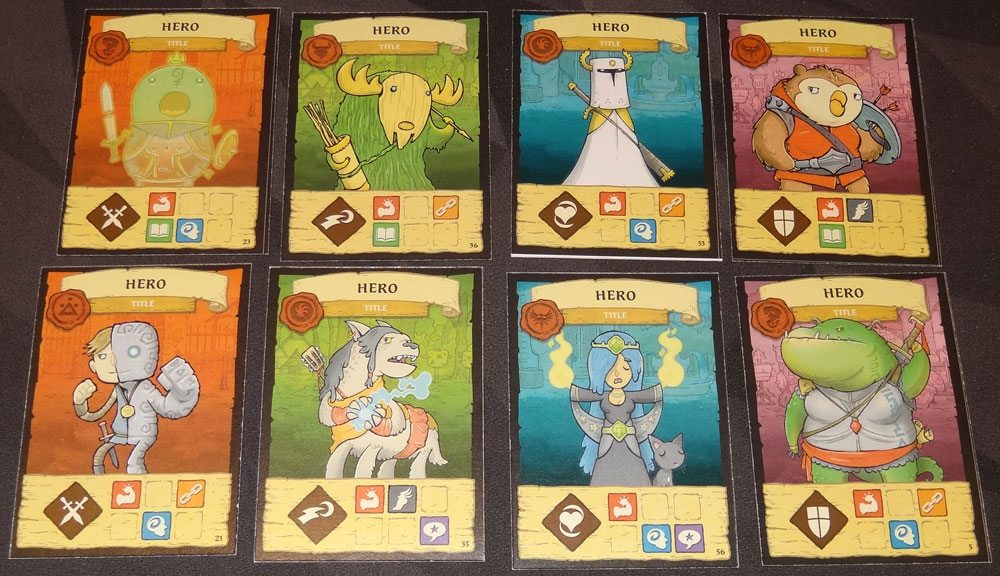
The game consists mostly of different types of cards—lots of cards. The artwork in the game is mostly done by Justin Hillgrove, who also did the artwork for JunKing, the previous title from Junk Spirit Games. In fact, Junk Spirit Games ran a Kickstarter for a hardcover book of Hillgrove’s artwork, and when I saw the Junk Spirit booth at Gen Con last summer, I was a bit regretful that I hadn’t backed it. His creatures in particular—the monsters and the heroes—are just wonderful. I love the cartoony look to them, and the fact that the heroes come in all shapes and sizes and genders. Graphic designer Zachary Vail is responsible for most of the card backs, and these are all nicely done as well, with a sealed envelope for the Queen’s Orders, a small backpack for the items, and so on. The artwork on this game looks wonderful, and I like that nothing is too scary or creepy, so it’s very kid-friendly.
The board itself looks like a portion of the kingdom, with various spaces to place cards, and some charts that indicate effects of threats on your villagers, regions, and heroes. The one thing I found was that there is a lot of empty space on the board that I felt could be utilized for other things—like discard piles for the items and location cards. On the one hand, it will cover up some of the artwork, but on the other hand, you would place a bunch of cards next to the board instead.
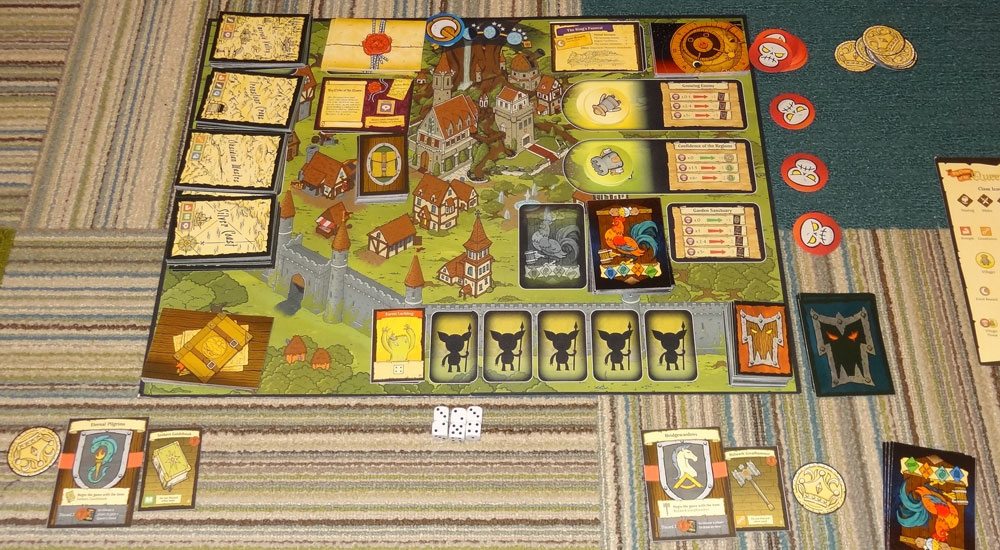
How to Play
The goal of the game is to work together to complete three of the Queen’s Orders before Tessandor is overrun by threats.
First, you’ll set up the board, placing the various decks of cards into their places: four different locations (Emerald Valley, Ironstone Crags, Obsidian Wastes, and Silver Coast), events, Queen’s Orders, items, quests, and heroes all have specific areas of the board. There’s a special King’s Funeral event card that starts on top of the event deck. The monster deck will have three of the special nemesis cards shuffled into it—one in the middle third and one in the bottom third—and then it is also placed on its spot on the board.
Put 18 villager tokens in the villager pool, and 11 region tokens into the region pool. Put the Time/Event token on the first moon phase at the top of the board. Reveal the first Queen’s Order card.
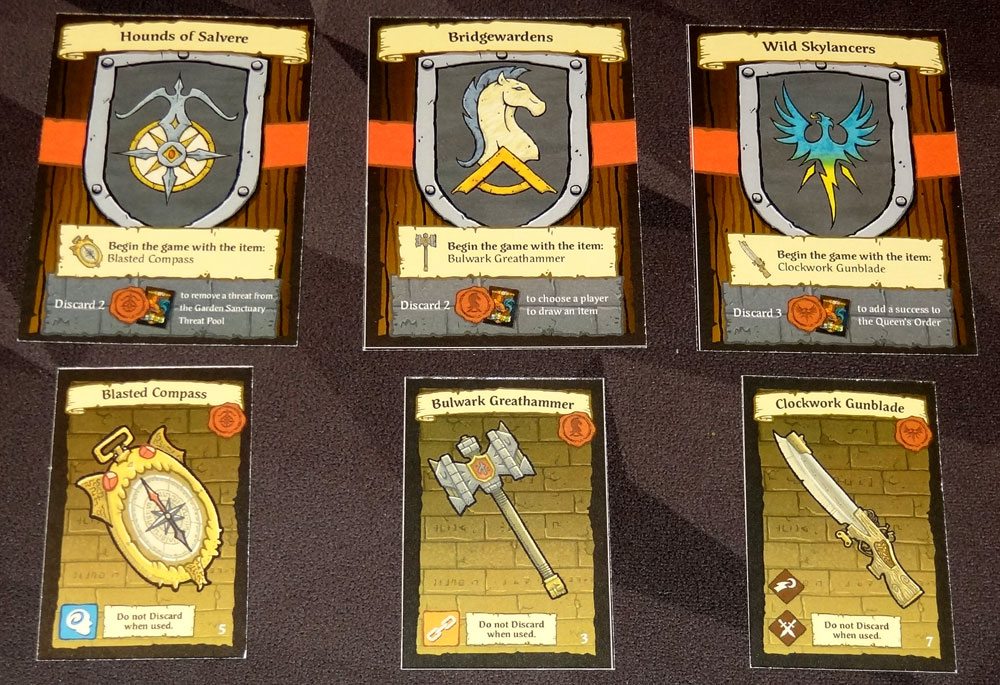
Each player gets a guild card, plus the specific item for their guild, and the other guild-specific items are removed. Each hero also gets 7 hero cards from the deck, and 1 Queen’s Favor token.
When the game starts, you draw the first Event (King’s Funeral) to begin—it will instruct you to place 1 threat token in each of the threat pools (Growing Enemy, Confidence of the Regions, Garden Sanctuary) and then draw 3 monsters and place them into the monster area.
The game is played over a series of turns. Every 4 player turns, when the Time/Event token reaches the full moon, there’s a new event phase.
On your turn, you take one of three actions:
- Quest
- Fulfill the Queen’s Order
- Fight Against the Horde
The Quest and Queen’s Order actions both require interacting with locations. To do so, you first assemble a team of 4 heroes from your hand. Each hero has an icon representing its class (Melee, Ranged, Shield, Healing) and three icons for its attributes (Strength, Constitution, Charisma, Dexterity, Wisdom, Intelligence). Each of the four locations has icons on the backs of the cards, indicating which attributes are most likely to show up in those locations—but it’s not guaranteed.

Once you draw a location card, there are three tests on it, and each test may have a reward on the left and a penalty on the right. There’s some flavor text about each test, and in the background there are icons indicating what type of tests they are. If you pass the first test, you go to the second test (green); if you fail, you go to the third test (red). In each case, you also get the reward or penalty for the test, depending on whether you passed or failed. If you pass the green test (i.e., you succeeded at both tests), you’ll get an event reward, which is shown on the current event card.

For attribute tests, you count up the attribute required among all your heroes and roll that many dice. For class tests, you count the number of the required class you have in your party and double it, and roll that many dice. If combat is required, you count the number of unique classes you have (up to 4) and roll that many dice. If any of the dice show a 5 or 6, you pass the test; otherwise, you fail. You may use a Queen’s Favor token to reroll one die, but each die may only be rerolled once.
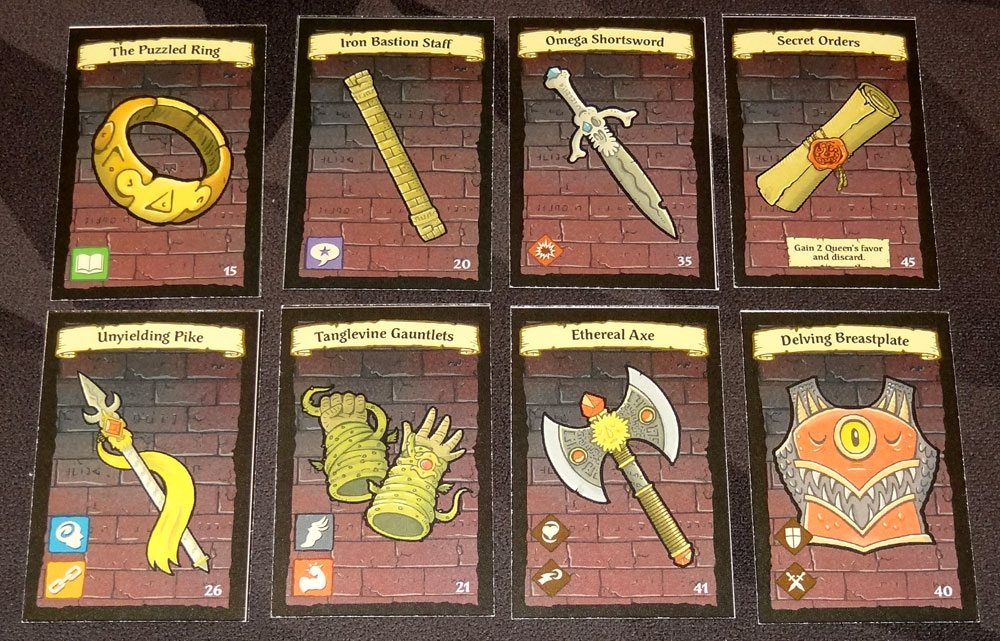
Items can be spent to add attributes, classes, or an extra combat die. Some items have immediate effects and are discarded, like letting you take a Queen’s Favor token. If you want to use an item, you must decide to use it before you roll the dice for a test, and then discard it. Your special guild items may be used at any time without being discarded.
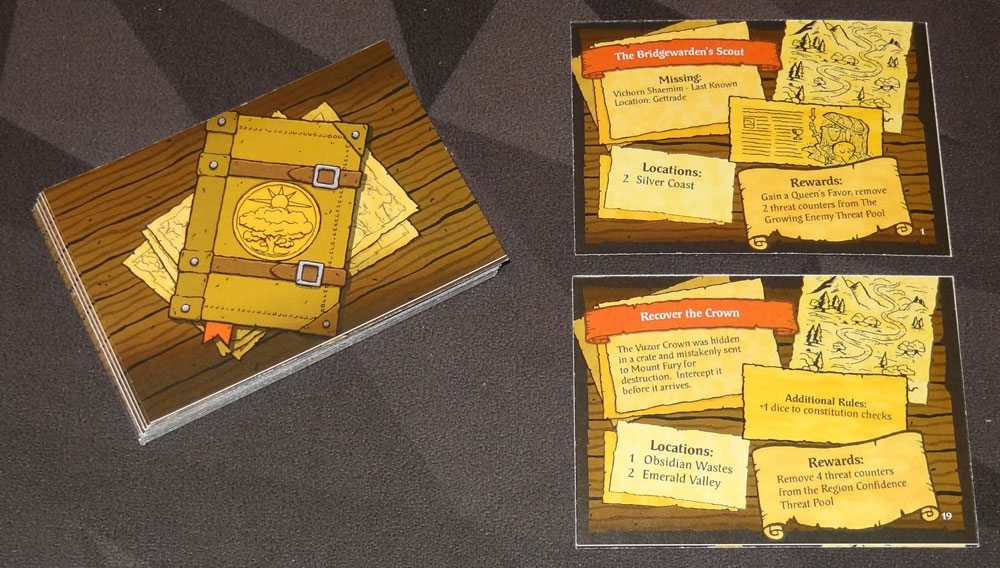
Quest: Draw 2 quest cards and keep 1. You may only have 1 quest at a time, so if you have an incomplete quest and want to keep a new one, you must discard the incomplete quest along with any progress you have made on it. Quest cards show some number of location cards required to fulfill the quest—choose one of those locations and draw a card from the deck, and then resolve it. (I’ll explain location cards below.) Then place the location card next to the quest to indicate your progress (whether you passed or failed the tests). If you’ve collected all the location cards listed on the quest, then you have now completed it—discard the quest card and location cards, and gain the reward.

Fulfill the Queen’s Order: Draw the location card indicated on the Queen’s Order, and resolve it. However, instead of getting the rewards if you pass a test, you put a success token on the Queen’s Order card instead. Also, after resolving the location, you also attempt the attribute test shown on the Queen’s Order card itself—if you pass, you may add another success to the Queen’s Order. Discard the location card.

Fight Against the Horde: You can fight off the monsters that are accumulating in the monster area of the board. Assemble your team of 4 heroes, ideally making a team with as many classes as possible, since you roll one die per unique class in your party. Make a combat test, but instead of needing 5 or 6, you must match or exceed the dice values shown on the monsters. You may assign your dice to any of the available monsters, placing a success token over the dice icons that have been met. Once all of the dice icons on a monster have been covered, the monster is defeated and is placed in your trophy pile. After combat, each monster still in play will retire one hero from your party, placing it in the retired hero stack.

In the monster deck, there are also two nemesis cards. When those are revealed, you find the matching large nemesis card and place it over the current Queen’s Order. The Queen’s Order may not be fulfilled until the nemesis is defeated. When fighting against a nemesis, you must retire a hero for each die that was lower than the required number for the nemesis. When you defeat a nemesis, you gain the rewards shown, plus remove 3 threat tokens from each threat pool.
End Turn: At the end of your turn, no matter which action you took, you discard your party to the hero discard pile on the board. Each guild has a bonus effect if you discarded a certain number of heroes of your own guild. Then draw back up to 7 heroes, reshuffling the hero discard pile if needed. Advance the moon phase. If the moon phase is on the full moon, it triggers an event phase. Otherwise, the next player takes their turn.

During an event phase, you do the following:
- Remove one villager token for each monster in play.
- Spawn monsters based on the Growing Enemy threat pool. If there are not enough spaces, remove villagers instead.
- Remove region tokens based on the Confidence of the Regions threat pool. (If there are no threat tokens, one hero gains a Queen’s Favor token.)
- Remove hero cards (placing them in the retired hero stack) based on the Garden Sanctuary threat pool. (If there are no threat tokens, one hero gains an item.)
- If the Queen’s Order has at least 8 successes on it, players get to choose a reward from it, and then draw the next Queen’s Order.
- Any player may turn in 4 monster trophies to draw an item card and remove 2 threat from Growing Enemy threat pool.
- Draw a new event card, adding threat to the threat pools as shown and noting the immediate effects on the card.
- Each player passes 1 hero to the left.
You win the game by completing three of the Queen’s Orders. If at any time you must discard a villager or region token or retire a hero and there are none left, then you lose the game.
The Verdict
I met David Gerrard at Gen Con 2016—he had a booth way in the back corner of the exhibit hall, and I recognized Justin Hillgrove’s artwork, and stopped by to check it out. I ended up buying a copy of JunKing, but I was really excited about By Order of the Queen. At the time, he mentioned a little about it and said it was a role-playing-ish board game designed to be kid-friendly, because he designs games that he can play with his own daughters.
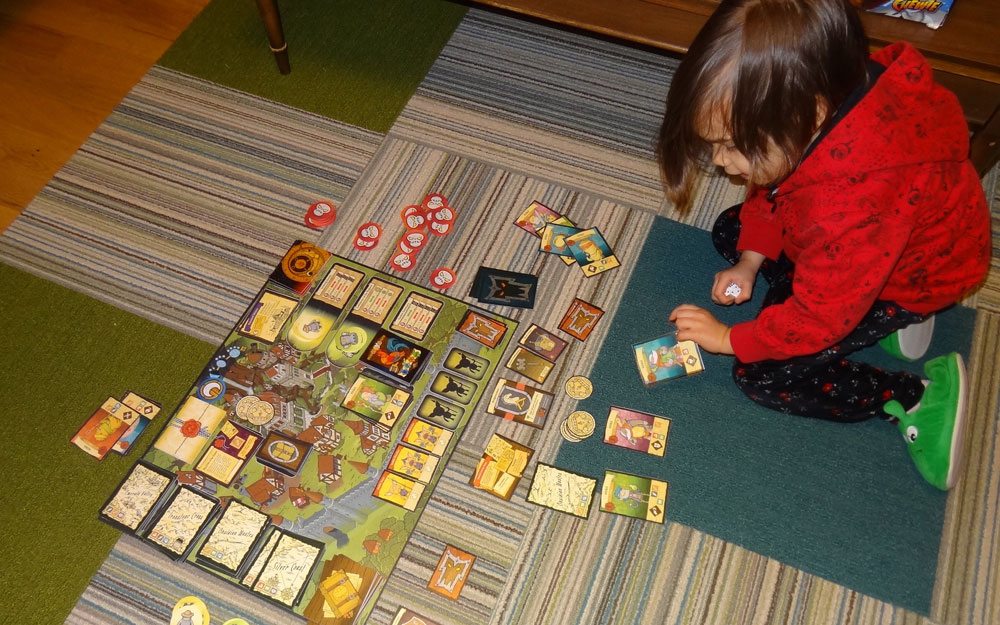
First, a testimonial: when I received the prototype to try out, I spread all the pieces out on the living room floor so I could read through the rules, and my three-year-old asked me what it was, and said she wanted to play. I figured, sure, it’ll let me walk through the rules a bit, see how the game works, and when she gets tired of it we’ll put it away. She ended up playing a full game because she liked it so much—it took us over an hour—and immediately wanted to play again. (But it was naptime, so we played again after dinner instead.) Sure, she couldn’t read all the location cards and didn’t have a real understanding of what the events and quests meant, but she picked up enough to know how to assemble a team of heroes, how to use items, what numbers she needed to roll to succeed at a test, and even what heroes to pass to me at the end of an event phase. That evening, when my older daughters were home from school, she was even explaining parts of the game to her older sister.
Since then I’ve gotten a chance to play again with my 10-year-old as well, and she also enjoyed it. It’s not a really heavy game, but it has a nice balance for a cooperative game, and it is also easily tweaked to make it easier or harder if you want to throw in some house rules. If you start with fewer villagers, regions, or heroes, it’ll be harder. Require fewer successes on a Queen’s Order (or fewer Queen’s Order cards) and the game is easier and shorter.
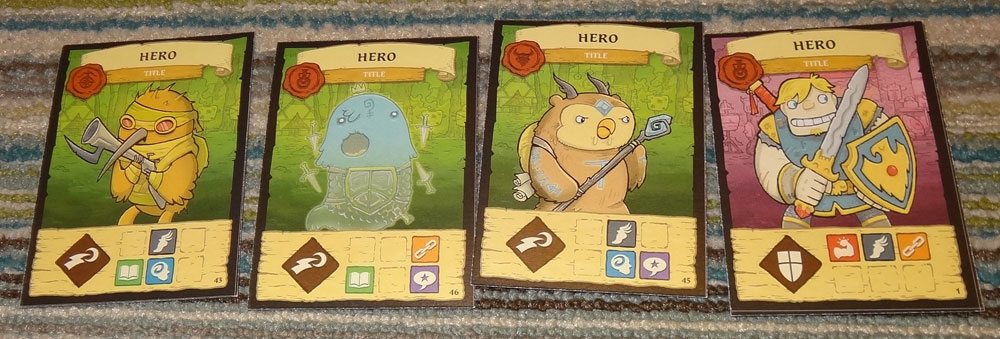
All of us enjoyed assembling our parties for the challenges. Although the location card backs show you what symbols are likely to come up, it’s usually important to have a little bit of diversification, just in case you draw an attribute test that isn’t listed on the back—otherwise, you roll no dice at all, and automatically fail that test. We also tried as much as possible to have all four classes represented, just in case combat was involved.
There’s a nice tension between putting out fires (for instance, fighting monsters so they don’t eat up all your villagers) and dealing with your long-term goal by fulfilling the Queen’s Order. You have to address immediate concerns to prevent total loss, but when you work on the Queen’s Order you sacrifice some of the immediate rewards that can help you keep the threat levels down.
The little story bits you get while going on quests and interacting with location cards are fun. They’re just little scraps of stories, but they help tell the story of Tessandor and make it more interesting than just rolling a specific number of dice for no particular reason. Of course, since the cards are randomly drawn, By Order of the Queen doesn’t play out a particular cohesive storyline the way a traditional RPG would, but you get an overall sense of bands of heroes traveling around and taking part in short quests. I think it can set the stage for kids to play more involved RPGs but is itself more of a cooperative board game, and somebody who is more experienced with being a game master would probably be able to take those little vignettes and weave them together into a cohesive whole.
The luck of the draw does mean that some games will be easier than others. We had one game in which we kept drawing events that increased threat in the Confidence of the Regions the most, but the quests we were drawing (with the hopes of finding one that let us reduce threat there) only addressed the other two threat pools, which were low. We lost the game due to losing all of our region tokens. Gerrard told me that they have been doing some rebalancing so that this situation is less likely to occur, but I do think it’s similar to any cooperative game: sometimes you’ll get a bad draw and it’s just going to be a bit harder, and you play again.
All in all, I think By Order of the Queen is a really beautiful, family-friendly game that straddles the line between RPG and board game. As far as cooperative games go, it may be on the easier (and simpler) end of things, but that’s not a bad thing. I really love all of the creatures and characters that Justin Hillgrove has created for the game, and I’m hoping that even more will be added through stretch goals before this is all finished. If you want a game that lets your kids dip their toes in the world of fantasy RPGs, it’s definitely worth a look.
For more information or to make a pledge, visit the By Order of the Queen Kickstarter page!



